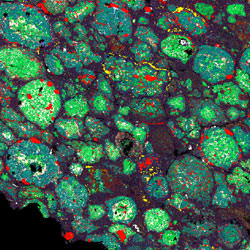
Different concentrations of elements in a meteorite: magnesium is green, calcium is yellow, aluminium is white, iron is red and silicon is blue. Image credit: Open University. Click to enlarge.
Researchers trying to work out how the planets formed have uncovered a new clue by analysing meteorites that are older than the Earth.
The research shows that the process which depleted planets and meteorites of so-called volatile elements such as zinc, lead and sodium (in their gaseous form) must have been one of the first things to happen in our nebula. The implication is that ‘volatile depletion’ may be an inevitable part of planet formation – a feature not just of our Solar System, but of many other planetary systems too.
The researchers at Imperial College London, who are funded by the Particle Physics and Astronomy Research Council (PPARC), reached their conclusions after analysing the composition of primitive meteorites, stony objects that are older than the Earth and which have barely changed since the Solar System was made up of fine dust and gas.
Their analysis, published today in the Proceedings of the National Academy of Sciences, shows that all the components that make up these rocks are depleted of volatile elements. This means that volatile element depletion must have occurred before the earliest solids had formed.
All of the terrestrial planets in the Solar System as far out as Jupiter, including Earth, are depleted of volatile elements. Researchers have long known that this depletion must have been an early process, but it was unknown whether it occurred at the beginning of the formation of the Solar System, or a few million years later.
It might be that volatile depletion is necessary to make terrestrial planets as we know them -as without it our inner solar system would look more like the outer solar system with Mars and Earth looking more like Neptune and Uranus with much thicker atmospheres.
Dr Phil Bland, from Imperial’s Department of Earth Science and Engineering, who led the research, explains: “Studying meteorites helps us to understand the initial evolution of the early Solar System, its environment, and what the material between stars is made of. Our results answer one of a huge number of questions we have about the processes that converted a nebula of fine dust and gas into planets.”
Professor Monica Grady, a planetary scientist from the Open University and member of PPARC’s Science Committee adds, “This research shows how looking at the tiniest of fragments of material can help us answer one of the biggest questions asked: ‘How did the Solar System form?’. It is fascinating to see how processes that took place over 4.5 billion years ago can be traced in such detail in laboratories on Earth today.
For planetary scientists, the most valuable meteorites are those that are found immediately after falling to earth, and so are only minimally contaminated by the terrestrial environment. The researchers analysed around half of the approximately 45 primitive meteorite falls in existence around the world, including the Renazzo meteorite which was found in Italy in 1824.
Dr Phil Bland is a member of the Impacts and Astromaterials Research Centre (IARC), which combines planetary science researchers from Imperial College London and the Natural History Museum.
Original Source: PPARC News Release
